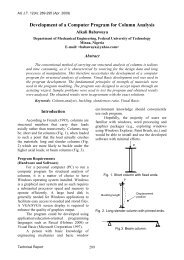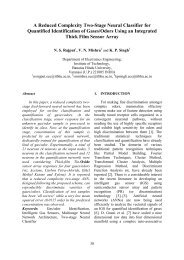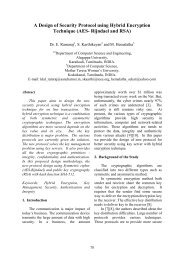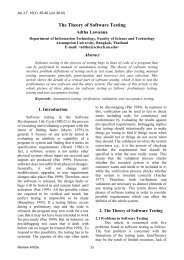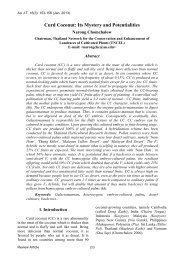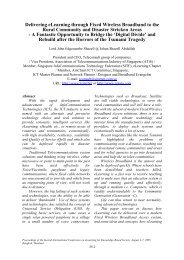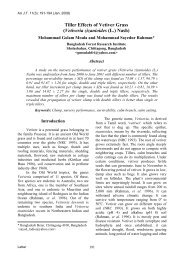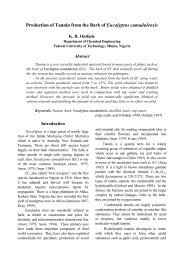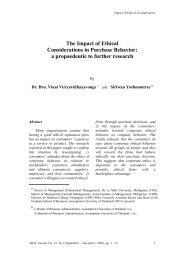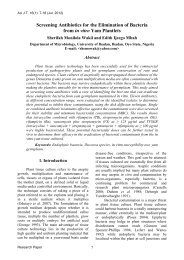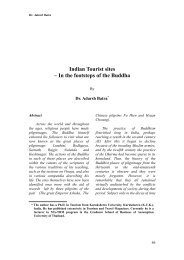PDF format - AU Journal - Assumption University of Thailand
PDF format - AU Journal - Assumption University of Thailand
PDF format - AU Journal - Assumption University of Thailand
You also want an ePaper? Increase the reach of your titles
YUMPU automatically turns print PDFs into web optimized ePapers that Google loves.
was too difficult for them and stated<br />
that they were unable to answer the<br />
theoretical questions. A number <strong>of</strong><br />
respondents stated that they did not<br />
have any knowledge at all about ESP.<br />
On the whole, it was extremely<br />
difficult to motivate the staff <strong>of</strong> tertiary<br />
institutions to respond to the<br />
questionnaire. This seems to have<br />
related to a number <strong>of</strong> factors. What is<br />
evident is that many felt that the<br />
questionnaire was simply an intrusion<br />
into an already over-loaded schedule.<br />
The combination <strong>of</strong> over-work, fear,<br />
suspicion and anxiety that language<br />
teachers in Thai tertiary institutions<br />
appear to suffer from is not conducive<br />
to effective innovation. Only when<br />
teachers feel adequately trained and<br />
experienced and effectively supported<br />
by their institutions are they likely to<br />
be willing to discuss possible<br />
improvements openly and with<br />
confidence. Only when they feel that<br />
innovation involves unthreatening<br />
partnership are they likely to welcome<br />
it. Successful innovation is likely to<br />
take place where there is confidence,<br />
trust and pr<strong>of</strong>essional security.<br />
<strong>Thailand</strong> must acknowledge that the<br />
process <strong>of</strong> change is likely to be a long<br />
and gradual one and that it must involve<br />
the acknowledgment <strong>of</strong> the need for<br />
true pr<strong>of</strong>essionalism in language<br />
teaching and, therefore, <strong>of</strong> the need for<br />
a comprehensive policy on language<br />
teacher education - a policy that <strong>of</strong>fers<br />
opportunities to everyone involved.<br />
References<br />
Allwright, R. (1984). “Why don’t<br />
learners learn what teachers teach?:<br />
The interaction hypothesis.” In D.<br />
Singleton & D. Little (Eds.).<br />
Language learning in formal and<br />
informal contexts (pp. 3-18).<br />
Dublin: IRAAL.<br />
Andrews, S. (1984). “The effect <strong>of</strong><br />
arabicization on the role <strong>of</strong> service<br />
English.” In J. Swales & H.<br />
Mustafa, (Eds.). ESP in the Arab<br />
world (pp. 172-84). Birmingham:<br />
Language Services Unit, <strong>University</strong><br />
<strong>of</strong> Aston.<br />
Holliday, A. (1992). “Tissue rejection<br />
and informal orders in ELT<br />
projects: Collecting the right<br />
in<strong>format</strong>ion.” Applied Linguistics,<br />
13 (4), pp. 403-424.<br />
Kirkpatrick, A & Prescott, D. (1995).<br />
“Whose course is it anyway? Why<br />
we need a new ELT teacher<br />
education course.” Expanding<br />
horizons in English language<br />
teaching (pp. 95-107). Selected<br />
Papers Presented at CULI’s Third<br />
International Conference 27-29<br />
November 1995, Bangkok <strong>Thailand</strong>.<br />
Nunan, D. (1995). “Closing the gap<br />
between learning and instruction.”<br />
TESOL Quarterly, 29 (1), 133-158.<br />
______



